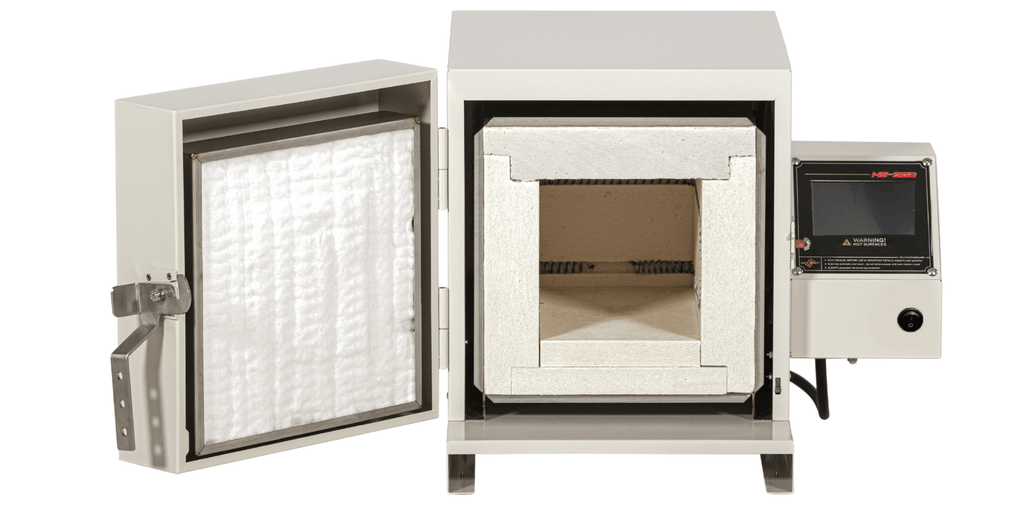The 7 Best Pottery & Ceramic Kilns for Home Use
In the world of pottery and ceramics, the kiln is an essential tool for firing clay creations to perfection. Whether you're a novice artist exploring your creative side or an experienced ceramicist honing your craft, having the right at-home kiln can make all the difference in achieving the desired results. In this article, We asked our resident Master Potter, Paul Hughes for his take on the seven best ceramic and pottery kilns suitable for at-home use to help you make an informed decision for your artistic journey.
First Off, Can You Have a Pottery Kiln at Home?
Yes, you can have a pottery kiln at home, as long as it's installed safely and in the right environment. These kilns get extremely hot, so they should be placed in a well-ventilated space like a garage or utility room with non-combustible flooring and at least 18 inches of clearance on all sides. It’s also important to make sure your electrical system is up to the task.
Some kilns require a dedicated circuit or professional installation. With a few smart setup choices, having a kiln at home can be both safe and convenient. Later in this guide, we’ll walk you through the best kilns for home use to help you find the right fit for your space and creative goals.
The Best Pottery Kilns for Home Use
A home pottery kiln can cost between $1,500 to $4,000 depending on the features you want and the projects you'll be firing. Some things you'll want to consider are the size, voltage, and temperature range of the kiln. We'll get more into this later.
7. Olympic Traveler 120v

This is a great kiln for low-fire ceramics, especially if you need a kiln that is easy to transport and then put away in a closet or in somewhere in your home studio. You will need a 120v / 20 amp dedicated circuit for this kiln, but with a top temperature of 2000º F, it will handle all of your low-fire ceramic needs.
Related (If you're in the market): Best Kilns for Glass Fusing
6. Paragon Terra Fusion

This is another great kiln for low-fire ceramics. It is lightweight due to its all-fiber construction and you can plug it into most 120v / 15 amp grounded household outlets. The Home Artist fires to 1900º F and will make firing your china paints and low-fire ceramics a breeze. At less than 50 pounds, it is super easy to move around on the included wheels, and you can put this one away in a closet when you’re not using it as well.
5. Olympic Doll - E/Test Kiln

Two names for one kiln?
Initially, the Olympic Doll E kiln was a primary kiln purchase for artists making ceramic dolls and later became a hot ticket item for labs, universities testing glaze, tiles, etc. because of the oval design. Olympic kept both names for the model so that customers who purchase the model for either reason would recognize it if they needed future purchases or parts.
4. Evenheat HF 810
Evenheat makes superb kilns. Their design and construction are pure elegance of craftsmanship. The HF 810 will fire to cone 8 on a 120v / 20 amp dedicated circuit, and with four controller choices and the option of solid state relays you can have this kiln built to your exact specifications and it will last a lifetime. The firing chamber is 11 inches in diameter and 9 inches deep, perfect for mugs, bowls, and even small plates.
3. Paragon Max 119
The Max 119 is another great 120v kiln that will fire to cone 8 on a dedicated 120v / 20 amp circuit. Paragon kilns are built like tanks, and the Max 119 is no exception. The Max 119 has an extra 2 inches of insulation between the 2.5" brick walls and the outer steel case, so you have 4.5 inches of insulation between the elements and the outside of the kiln. That is solid!
2. Hot Shot Oven and Kiln HS-360

The Hot Shot HS-360 might not be the first kiln you think of for pottery, but it actually works very well as a low-fire ceramic kiln. It fires to 2000º F, has an all-fiber firing chamber, stays cool to the touch on the outside even when firing, and has an interior that is 6 inches wide, 6 inches tall, and 10 inches deep. For ceramic work, the 15 amp version has ample power and that means you can plug it into a regular grounded household outlet.
1. Evenheat RM II 810
Like its sister the HF 810, the Evenheat RM II 810 is a great ceramic kiln. The top temperature on the RM II 810 is a little lower, 2200º F or cone 5 1/2, but you can add a hold to the end of your firing to get to cone 6 with this kiln. This kiln also requires a 120v / 20 amp dedicated circuit and has the same great build quality as all Evenheat kilns.
What to Look for in a Kiln
You're looking for the best kiln for your home studio, but you don't know what to look for. If this sounds like you, you're not alone and we're here to help you. When selecting the perfect pottery kiln for your home, you need to consider several factors.
Electric or Gas Kilns
Electric kilns offer several advantages that make them the preferred choice for many ceramic enthusiasts, especially for bisque firings. They are also commonly found in households due to the ease of use and the regulatory challenges associated with gas kilns.
Electric kilns are also significantly easier to operate compared to their gas counterparts. This user-friendliness makes them one of the best kilns for beginners and experienced ceramic artists. You won't need extensive training to get started with electric kilns.
Obtaining permits for gas kilns can be a cumbersome process due to safety regulations and the need for proper kiln ventilation. Electric kilns, on the other hand, are much simpler to set up in a home studio, making them a practical choice for aspiring potters and ceramicists
What About Gas Kilns?
Gas kilns, in contrast, have distinct characteristics that separate them from electric kilns. Gas kilns tend to yield ceramics with earthy and muted color palettes. This is due to the reduction environment they create, where the fire consumes oxygen, altering the chemical composition of glazes and clay. While this can produce unique and rustic effects, it differs from the vivid hues of electric kilns.
All gas kilns can be used with either natural gas or propane, providing flexibility in fuel choices based on availability and convenience. In the market, you'll find that the vast majority of kilns sold are electric. This is not only a testament to their ease of use but also a reflection of their suitability for home use. If you're considering starting your ceramic journey from the comfort of your own space, an electric kiln is highly recommended. It allows you to create pottery with vibrant colors while keeping the process straightforward and accessible.

A customer smiles next to one of our electric HB89 Olympic Kilns!
Temperature Range
Choosing the right kiln depends heavily on the temperature requirements of your ceramics projects. To determine the most suitable kiln, you must first assess whether your chosen materials and glazes necessitate a high, medium-high, or medium-low firing temperature.
Low-fire materials, like earthenware and certain types of glass, are best suited for lower-temperature kilns. Stoneware, on the other hand, is versatile and can be fired in mid-range or high-temperature kilns. The highest-firing kiln temperatures are reserved for porcelain. It's crucial to invest in a kiln that can surpass the maximum temperature required for your specific work.
Keep in mind that kilns gradually lose their ability to maintain high temperatures as they age. To compensate for this, it's advisable to set your minimum required firing temperature at 200-300 degrees Fahrenheit higher than what you initially calculated.
While exploring different kiln models, you may have encountered temperature measurements referred to as "cones." Cones differ from Fahrenheit degrees as they represent both temperature and time, reflecting the energy required for firing. Lower cone temperatures are denoted by numbers with a leading zero, such as 018, 019, and 020, while higher cone temperatures are two-digit numbers like 12, 13, and 14. The highest cone temperature is 15, and the lowest is 022. When selecting a kiln, be sure to cross-reference the recommended cone temperatures for the specific materials and glazes you intend to use. This will help you make an informed choice and achieve the desired results in your ceramics projects.
Electricity and Voltage
When considering an at-home kiln, electricity and voltage are two big factors. There are certain standards you need to meet for both if you want to find the right kiln for your projects.
Voltage:
- The standard household voltage is 120V, which is suitable for smaller kilns.
- Larger kilns often require 240V. If you plan to install one in your home, it's advisable to consult an electrician to ensure your electrical system can support it safely.
Amperage:
- Check your breaker's amperage rating. You can find this information in the fuse/breaker box of the plug you intend to use.
- Most U.S. homes are protected by 15-20 amp breakers, which are sufficient for smaller kilns.
- However, larger kilns may require 60 amps or more. Even if you have the correct voltage, the kiln won't function if the amperage isn't high enough.
What Size Kiln Should I Get for My Home?
For most home potters, smaller kilns (up to 9” x 11”) are ideal. They're perfect for firing beads, doll parts, small items, and test pieces, making them an excellent choice for beginners.
If you're aiming for slightly larger creations like pots, plates, and bowls, but not in large quantities, an 18” x 18” medium kiln suits your needs. It also accommodates those who prefer making several small items that won't fit in a smaller kiln or are part-time potters.
For the average potter, a 23” x 27” kiln is the most common choice. It offers versatility for various projects. On the other hand, if you're planning on large-scale production, a 29” x 27” kiln is the best bet.
Top Loading vs. Front Loading
When choosing between a top-loading and front-loading kiln, it's important to think about your height and back health. Top-loading kilns are cheaper but can be challenging if you're not tall. Using a stool is an option but might strain your back. Front-loading kilns are more user-friendly, as they eliminate the need for awkward reaching. However, they tend to be pricier. Your decision should consider how much the kiln costs, comfort, and how often you'll use the kiln.
Kiln Furniture & Accessories
When calculating the cost of a kiln, remember to factor in kiln furniture expenses. Kiln furniture, made by reputable manufacturers, is essential for efficient firing. It ensures rapid heating, minimal heat loss, and consistent temperature control. Poorly constructed furniture can be problematic, especially with electric kilns.
Kiln furniture includes components like bricks, shelves, bead racks (for wearable ceramics), kiln posts, and stilts. There isn't a one-size-fits-all material, as it depends on your specific needs.
To simplify your purchase and avoid extra shipping fees, consider getting a furniture kit along with your kiln. This kit typically includes the necessary furniture items you'll require.
Choose Your Kiln To Do Pottery at Home Today
Owning a pottery or ceramic kiln opens up endless possibilities for artistic expression. Each of the seven kilns mentioned here has its unique features, catering to different needs and preferences. Whether you prioritize size, precision, or budget-friendliness, there's a kiln on this list for you. Remember to consider the key factors discussed when making your choice, and let your creativity flourish in the world of ceramics.







Leave a comment